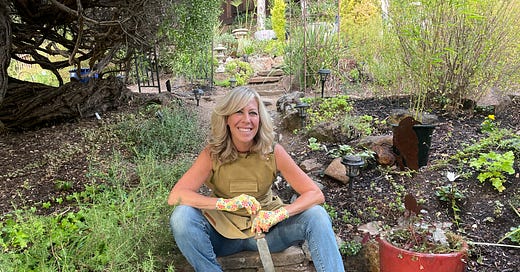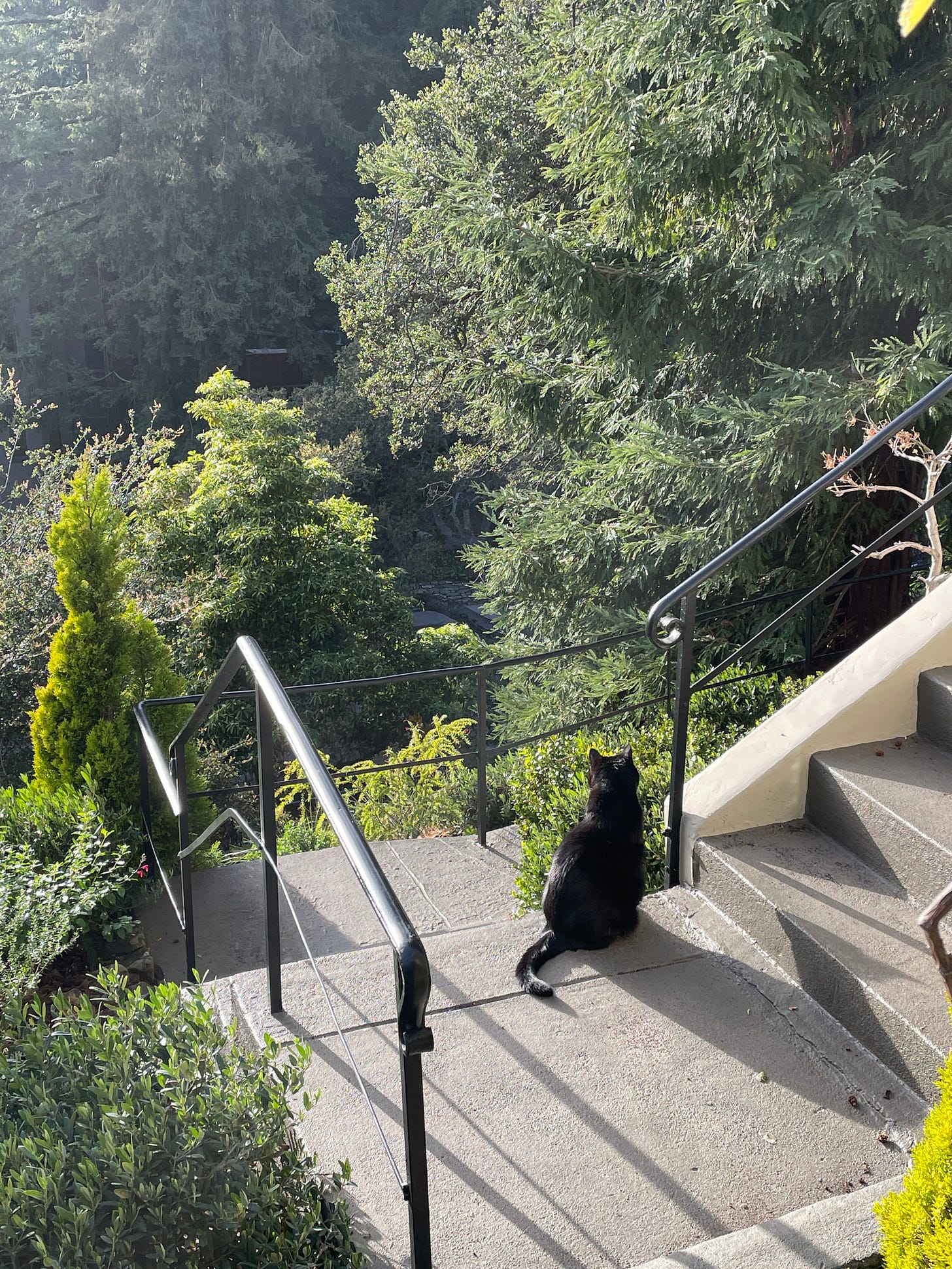To Weed or Not to Weed: What to Pull (or Keep) When Creating a Backyard Wildlife Habitat
The surprising lessons that come from pulling weeds—both in the garden and in life
Today was a good day.
I was chased by an angry bumblebee defending her nest.
I discovered where poison oak lives under the redwood tree — the same poison oak that got the best of me last week.
I spent 5 hours pulling hundreds (thousands?) of individual invasive, self-seeding, evil little plants
My backyard native wildlife habitat restoration project has been one of the most exciting—and back-breaking—endeavors I’ve ever taken on. And I’m having a blast, despite the poison oak turning my face into an abstract painting and the enraged bumblebee forcing me to abandon my work and flee into the house. (I just pray no one saw me flailing my way to the door.)
Making Amends with the Land
If I have any regrets, it’s that over the years, I planted plenty of non-native species in my garden. Nothing invasive, per se—but certainly plants that didn’t co-evolve with the wildlife in our region and thus don’t provide the specific food, shelter, and nesting materials that native birds, bees, butterflies, and other wildlife have evolved to rely on. I’m making up for it by:
Planting an abundance of native shrubs and wildflowers—ones that attract pollinators, restore habitat, and thrive in our ecosystem. (I look forward to sharing this process with you.)
Removing invasive plants that crowd out native species—so that the available resources (space, light, water, and nutrients) can support the growth of native and beneficial plants, restoring balance to the ecosystem.
Today, we’re focusing on #2.
Creating a thriving, functioning backyard ecosystem isn’t just about what you add—it’s about what you remove, and in fact, that’s where you want to start regardless of how small or large your project (or space) is.
One of the things I’ve enjoyed most in this process is the patience, thoughtfulness, and curiosity it requires. (I can’t believe I just said I am enjoying “patience.”) And while it’s tempting to rip out anything that looks "weedy," I’ve found that taking the time to observe, learn, and make intentional choices has been just as rewarding as the transformation itself.
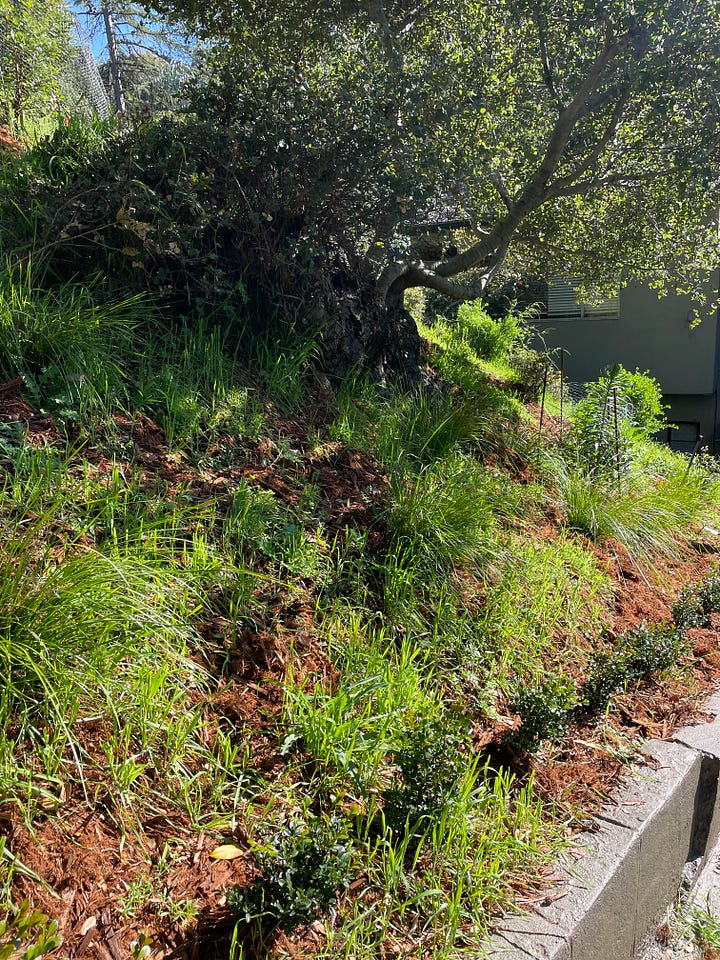
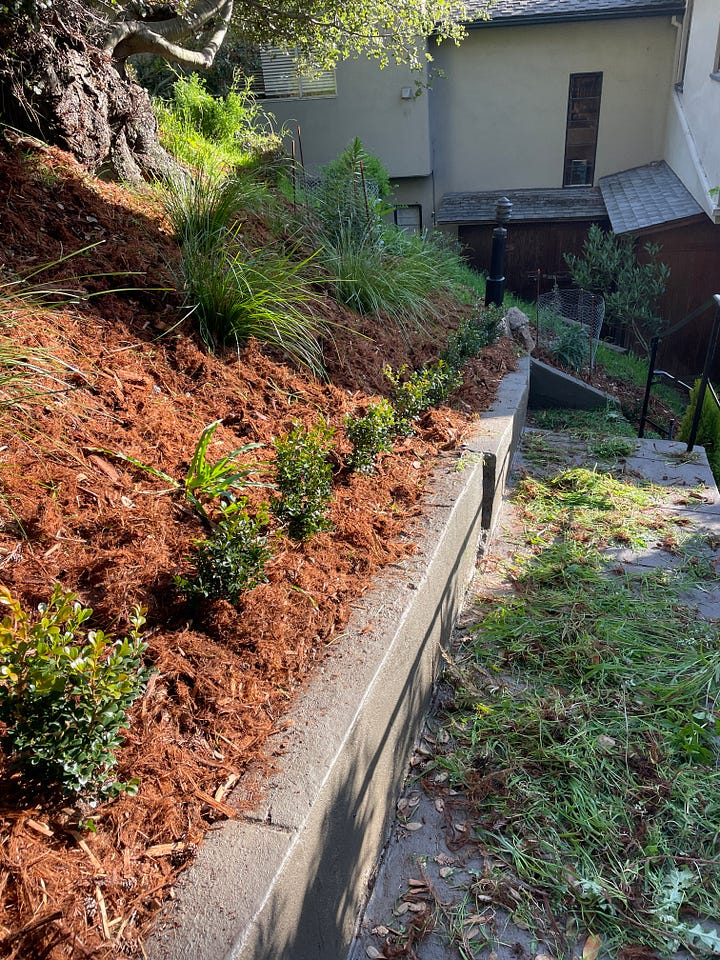
Use This Criteria to Determine Which Plants Stay and Which Ones Go
The usual labels of “good” and “bad” plants aren’t helpful when making decisions about what to keep or remove.
A plant dismissed as a weed in one region might be essential in another—feeding pollinators, preventing erosion, or supporting soil health.
Meanwhile, an ornamental species that looks beautiful in a garden can wreak havoc on local ecosystems if it spreads unchecked. (That’s a whole other topic, but for now, I highly recommend reading Douglas Tallamy’s book Bringing Nature Home: How You Can Sustain Wildlife with Native Plants.)
Also, when creating criteria, I know there’s a cute saying that goes, “A weed is just a plant growing where it’s not wanted.” It’s meant to challenge the stigma around weeds, but it still frames the issue through a purely human lens—as if a plant’s value is determined solely by whether or not we like it.
This definition ignores the ecological function of how plants interact with their environment. Some so-called weeds are vital sources of food and shelter for wildlife, while others aggressively displace native species, disrupt ecosystems, and deplete resources. The distinction isn’t about whether we want a plant in a certain place—it’s about what that plant does and how it affects the larger ecological balance.
That’s why, instead of asking Is this a weed? I find it far more useful to ask What does this plant do? and What impact does it have on the environment around it? These are my criteria, and these are the simple questions I recommend asking:
Is this plant native or non-native to my region?
Is it invasive or potentially spreading aggressively and outcompeting native plants?
Is it providing food or shelter for local wildlife?
What are the long-term consequences of leaving or removing this plant?
Now with these questions in hand, we can move onto Step One.
Step 1: Identify and Document
My go-to tool for answering these questions and identifying the plants in my gardens is PictureThis, an app I’ve found to be the most accurate and user-friendly. I’ve tried many, but what I love about this one is:
Accurate Plant Identification – Instantly identifies plants, flowers, trees, and weeds using AI-powered image recognition (and ability to offering ID corrections)
Detailed Plant Information – Provides scientific names, care instructions, and ecological roles (native, invasive, toxic, etc.).
Plant Health Diagnosis – Detects diseases, pests, and nutrient deficiencies, offering treatment suggestions.
Personalized Collections – Organize identified plants into categories (e.g., "Native Plants at Home" or "Invasive Species Removed").
Growing & Care Tips – Offers guidance on watering, light, soil, and pruning specific to each plant.
I know this will continue to evolve, but I created the following collections to help me. (I say “At Home,” because maybe I also want to create Collections when I travel.)
Native Plants at Home
Non-Native Plants at Home
Uncertain / Unidentified Plants
Invasive Plants at Home Removed / Removing (I definitely want to remember how much I’ve accomplished!
I can move plants in and out of these collections, add notes, take more photos, etc. There are a gazillion apps out there. Find the one that works best for you.
In terms of documenting, I should also say I’m keeping an online journal with even more details, and I’m also sharing my experience here with you. But the main thing is that you have some kind of easy way to identify and document the plants you want to keep or remove.
Step 2: Decide Next Steps
Now that I know what a plant is, the next step is deciding what to do with it.
Some plants are undeniable invaders, aggressively spreading and displacing native species, making them a priority for removal. (It’s hilarious how much satisfaction I derive from pulling them up.) Others are native and beneficial, meaning they belong here and actively support local wildlife.
Then there’s the middle ground—non-native but not necessarily harmful. These plants may not be invasive, and while they might not support specialist pollinators (more on that another time), they can still provide value to generalists.
So, I’ve sorted plants into three categories:
Remove – Because they’re invasive, harmful, or outcompeting native species.
Keep – Because they’re native and beneficial to my backyard, local ecosystem.
Manage – Because they’re non-native but either harmless or still somewhat beneficial.
When I say manage, I mean:
Keeping them contained in a small, controlled area where they don’t take over.
Culling them selectively, thinning them out instead of fully removing them.
Transplanting them to a pot or another area where they can be controlled.
I’m not going to bore you with every plant I’m dealing with in my specific region (Oakland, CA), but I’ll use a few examples below to illustrate how I’m making these decisions.
What I’m Happily Pulling
Invasive self-seeding grasses – Still trying to confirm species (possibly Panic Veldt Grass)
English Ivy – The never-ending battle
Poison Hemlock – Highly toxic and aggressively spreading
Poison Oak - Need I say more?
Annual Mercury – Common in disturbed soils, crowds out native plants
Australian Waterbuttons or Brass Buttons – A creeping non-native
Oxalis (Sourgrass) – A major invader in California, spreading via underground bulbs
Various Thistles – So many different types!
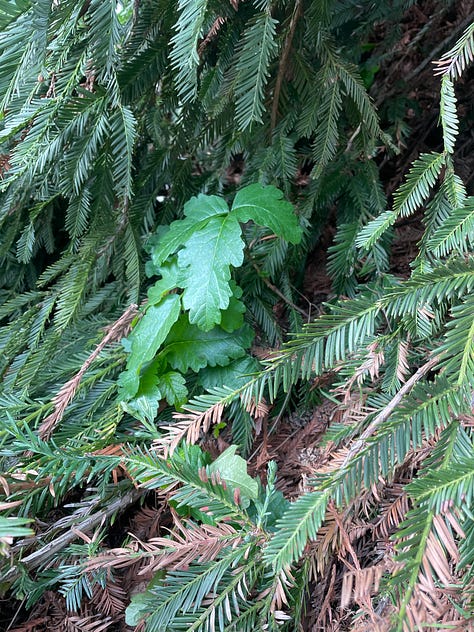
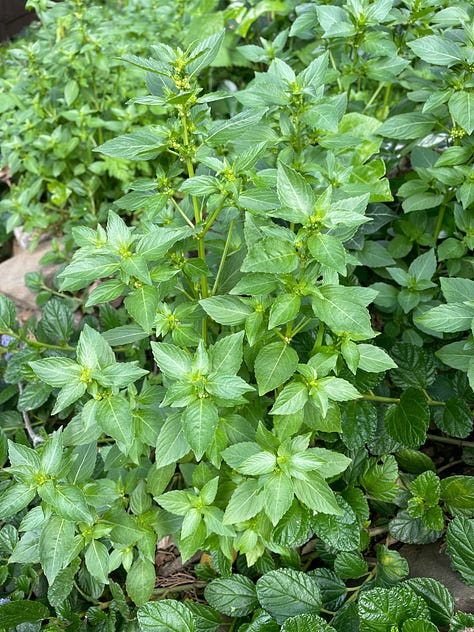
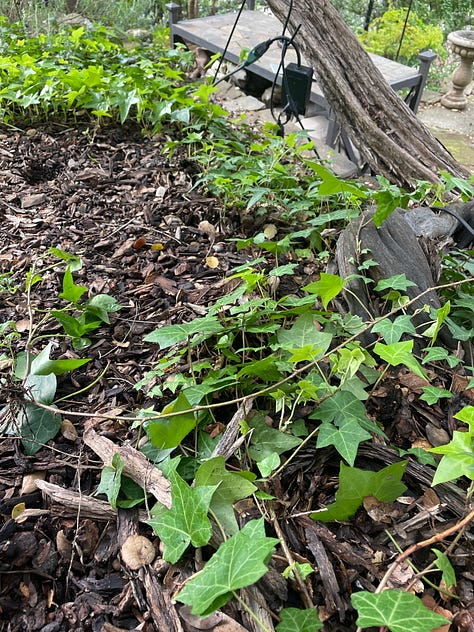
What I’m Joyfully Keeping
Miner’s Lettuce – A nutritious native edible that also supports local animals (see video for what it looks like)
Rough Hedgenettle – A native plant that supports pollinators
Ladies’ Tobacco (California Cudweed) – Supports butterflies and bees
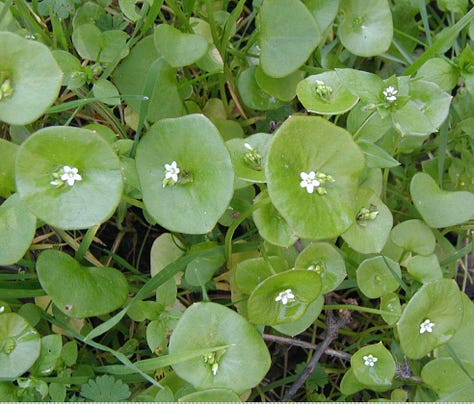
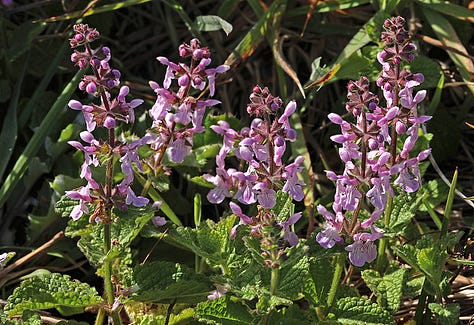
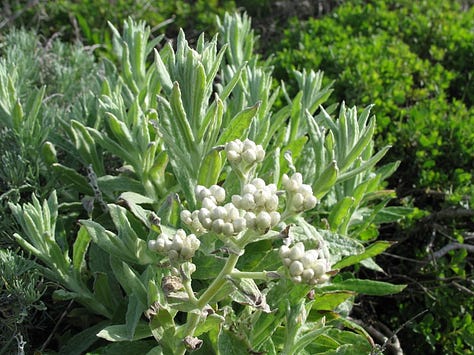
What I’m Managing (Not Fully Removing, But Controlling)
Cleavers – Sticky and fast-growing but valuable for wildlife
Mexican Daisy (Santa Barbara Fleabane) – Non-native but loved by generalist pollinators
St. John’s Wort – It will invade if I let it, so I’m taking the few I see and potting them. Wish me luck.
Step 3: Remove Invasive Plants (Methods)
Removing invasive plants isn’t one-size-fits all. The best method depends on your specific situation—your climate, soil type, rainfall, temperature, and especially the size of the area you’re working with. Some plants spread by deep roots, requiring persistence to fully eliminate, while others rely on seed dispersal, meaning removal must happen before they flower. Some invasives are easy to pull by hand, while others require sheet mulching, repeated cutting, or even solarization to be truly effective.
In other words, what works for me may not be exactly what works for you. But the key principles remain the same: be persistent, be strategic, and remove plants in a way that prevents them from coming back stronger.
For me, after 13 years at Little Montali (yes, I named our house) and significant work already done, most of the remaining invasive removal is on the front hillsides, where over 1,000 square feet has been overtaken by aggressive spreaders. Since these slopes already have established ornamentals (non-native but not invasive), sheet mulching or solarization aren’t practical options—there’s too much area, too many existing plants, and the terrain is steep.
Hand-pulling is my best option, even if it means tackling it one stubborn root at a time, and that’s what I’m doing. Literally, one plant at a time! There are many resources out there for you, should you need to employ other methods, but these are typically the options for residential areas:
Persistent Hand-Pulling (see video)
Sheet Mulching (Cardboard or Lasagna Mulching)
Solarization (Using Clear Plastic to Trap Heat and Kill Roots)
Careful Digging and Root Removal
Lessons and Gifts
An experience I had the other day provided the most wonderful encouragement and confirmation that I’m doing the right thing.
Because I’m pulling plant by plant, I’m interacting with each and every species I encounter. The other day, while yanking up one invasive after another, I spotted two tiny specimens of Miner’s Lettuce—a native herb ground cover I’ve never noticed in any of my gardens before. (Ironically, I had just sown a ton of seeds in another area to invite it in.)
It was as if they were saying, We’re here! We want to spread, thrive, grow, and support life. Clear away the dross around us that’s not helping anyone, and we’ll do our job!
And that’s exactly the point. This work isn’t just about removing plants—it’s about making space. Space for native species to emerge, for pollinators to find food, for an ecosystem that has been crowded out to regain its balance.
These two tiny plants weren’t struggling—they are standing at the ready. They are waiting for their moment, and the second they have room, they will flourish. That’s my job—to clear the way so they can thrive.
And isn’t that a lesson to live by? Growth isn’t just about adding what’s beneficial; it’s about clearing away what hinders, distracts, and diminishes. You won’t be surprised to know that I am reminded of a passage from Tao Te Ching (verse 48):
In the pursuit of knowledge, every day something is added.
In the practice of the Tao, every day something is dropped.
Less and less do you need to force things,
until finally you arrive at non-action.
When nothing is done, nothing is left undone.
May you find clarity, joy, and peace not just in what you cultivate, but in what you release.
Read more articles in the backyard rewilding series.
More Resources for You!
👉 Because the publisher took The Vegan Table (and Color Me Vegan) out of print, I am able to repurpose all of my recipes for which I own the copyright again. Please check out my Recipe E-Books and my library of On-Demand Cooking Classes for more tried and true recipes!
👉 Work with me 1:1 – Get personalized guidance to build healthier habits, cultivate self-compassion, communicate with conviction, strengthen emotional resilience, or whatever you are looking for.
👉 Read A Year of Compassion – Daily inspiration to help you live with intention, kindness, and compassion for humankind, animalkind, and the ecosystems we all depend on.
👉 Listen to Food for Thought – Inspiration for living compassionately, sustainably, and healthfully (18 years strong!)
👉 Travel with me! I host animal-friendly, luxury, all-inclusive vegan trips around the world, specifically curated to ensure high-quality, high-touch premium experiences. Check out our upcoming trips, and let me know if you have any questions.


